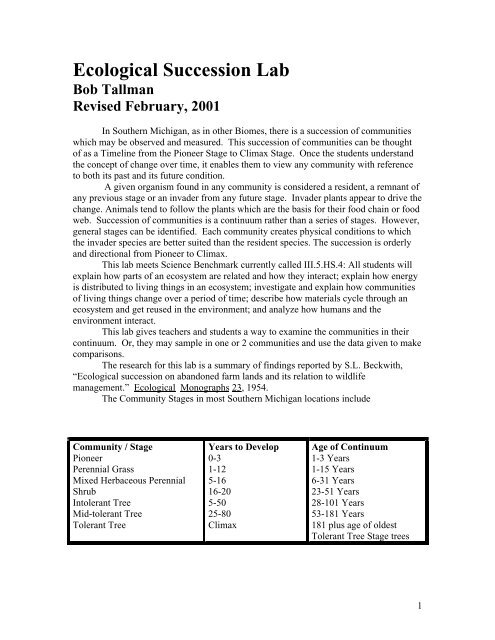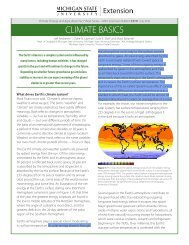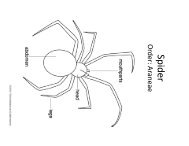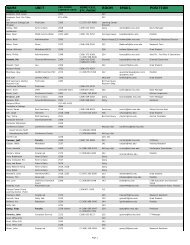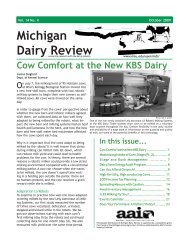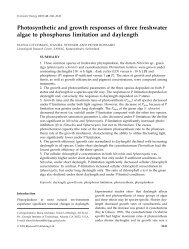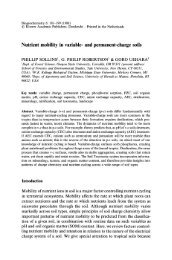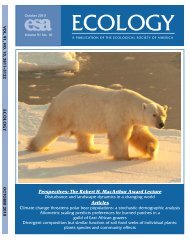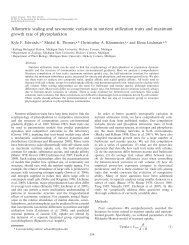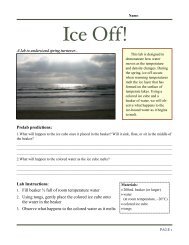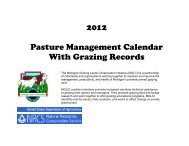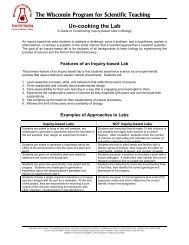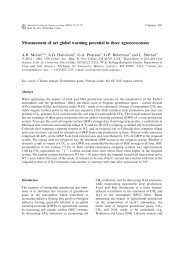Ecological Succession Lab
Ecological Succession Lab
Ecological Succession Lab
Create successful ePaper yourself
Turn your PDF publications into a flip-book with our unique Google optimized e-Paper software.
<strong>Ecological</strong> <strong>Succession</strong> <strong>Lab</strong><br />
Bob Tallman<br />
Revised February, 2001<br />
In Southern Michigan, as in other Biomes, there is a succession of communities<br />
which may be observed and measured. This succession of communities can be thought<br />
of as a Timeline from the Pioneer Stage to Climax Stage. Once the students understand<br />
the concept of change over time, it enables them to view any community with reference<br />
to both its past and its future condition.<br />
A given organism found in any community is considered a resident, a remnant of<br />
any previous stage or an invader from any future stage. Invader plants appear to drive the<br />
change. Animals tend to follow the plants which are the basis for their food chain or food<br />
web. <strong>Succession</strong> of communities is a continuum rather than a series of stages. However,<br />
general stages can be identified. Each community creates physical conditions to which<br />
the invader species are better suited than the resident species. The succession is orderly<br />
and directional from Pioneer to Climax.<br />
This lab meets Science Benchmark currently called III.5.HS.4: All students will<br />
explain how parts of an ecosystem are related and how they interact; explain how energy<br />
is distributed to living things in an ecosystem; investigate and explain how communities<br />
of living things change over a period of time; describe how materials cycle through an<br />
ecosystem and get reused in the environment; and analyze how humans and the<br />
environment interact.<br />
This lab gives teachers and students a way to examine the communities in their<br />
continuum. Or, they may sample in one or 2 communities and use the data given to make<br />
comparisons.<br />
The research for this lab is a summary of findings reported by S.L. Beckwith,<br />
“<strong>Ecological</strong> succession on abandoned farm lands and its relation to wildlife<br />
management.” <strong>Ecological</strong> Monographs 23, 1954.<br />
The Community Stages in most Southern Michigan locations include<br />
Community / Stage<br />
Pioneer<br />
Perennial Grass<br />
Mixed Herbaceous Perennial<br />
Shrub<br />
Intolerant Tree<br />
Mid-tolerant Tree<br />
Tolerant Tree<br />
Years to Develop<br />
0-3<br />
1-12<br />
5-16<br />
16-20<br />
5-50<br />
25-80<br />
Climax<br />
Age of Continuum<br />
1-3 Years<br />
1-15 Years<br />
6-31 Years<br />
23-51 Years<br />
28-101 Years<br />
53-181 Years<br />
181 plus age of oldest<br />
Tolerant Tree Stage trees<br />
1
Southern Michigan <strong>Succession</strong><br />
Pioneer Community<br />
The Pioneer Community is found on<br />
bare subsoil (soil without nutrients) and bare topsoil (such as in abandoned farmland). A<br />
Pioneer Community may also be found on tree bark or rock.<br />
On abandoned farmland, this community lasts about 0 – 3 years.<br />
The plants in this community are of four basic types: annuals, biennials, mosses<br />
(in moist or wet areas), and lichens (in dry areas). An annual is a plant that grows from<br />
seed, leafs out, flowers, and produces seed in one year. A biannual is a plant that grows<br />
from seed and leafs out the first year. After winter, the plant flowers and produces seed<br />
in the second year.<br />
Pioneer Community could become the Climax community with a lack of water<br />
and/or dry winds as in a desert or on a sand dune.<br />
The plants and animals that are examples of this community in Southern Tuscola<br />
County include:<br />
PLANTS<br />
Lichens<br />
Mosses<br />
Bermuda grass, Cynodactylon dactylon<br />
Biennial winter cress, Barbarea vulgaris<br />
Bindweed, Polygonum oilinode<br />
Blank medic, Medicago lupulinia<br />
Broad leaf plantain, Plantago major<br />
Chickweed, Stellaria media<br />
Chicory, Cichorium intybus<br />
Cinquefoil, Potentilla recta<br />
Common milkweed, Asclepias syriaca<br />
Crabgrass, Agropyron repens<br />
Creeping Charlie, Glechoma hederacea<br />
Dandelion, Taraxacum officinale<br />
Dry sandbur, Cenchrus pauciflorus<br />
Fall panicum, Panicum dichotomiflorum<br />
Foxtail grass, Setaria lutescens<br />
Ground ivy, Glechoma hederaceae<br />
Horsetail, Equisetum arvense<br />
Knotweed, Polygonum avicularia<br />
Narrow leaf plantain, Plantago lanceolata<br />
Peppergrass, Lepidium virginicum<br />
Prostrate spurge, Euphorbia supina<br />
Ragweed, Ambrosia artemisiifolia<br />
ANIMALS<br />
Killdeer, Charadrius vociferous<br />
Prairie deer mouse, Peromysuus<br />
maniculatus<br />
Savannah sparrow, Passerculus<br />
sandwichensis<br />
Vesper sparrow, Pooecetes maniculatus<br />
Wolf spider, Lycosa gulosa<br />
2
Red sorrel, Rumex acetosella<br />
Russian thistle, Salsola kali<br />
Shepherd’s purse, Capsella bursa-pastoris<br />
Spotted knapweed, Centaurea maculosa<br />
Winter cress, Barbarea vulgaris<br />
Witchgrass, Panicum capillare<br />
Wood sorrel, Oxalis europaea<br />
Yelllow rocket, Barbarea vulgaris<br />
Wild mustard, Bassica kaber<br />
Pioneer Community<br />
3
Southern Michigan <strong>Succession</strong><br />
Perennial Grass Community<br />
The Perennial Grass Community is characterized by grasses which mostly cover<br />
the ground. This stage usually lasts for 1 to 12 years. It usually starts suddenly but<br />
disappears gradually to the next stage. Mowing, light grazing, or yearly burning can<br />
prolong this stage so that it can be considered a Climax Community.<br />
There is the beginning of soil formation with the decay of dead plants and<br />
animals. Many of the plants are perennials, plants that, once sprouted, grow and flower<br />
year after year until competed out of the community. Usually, the top of the perennial<br />
plant dies each fall, giving the appearance of a dead plant, but the root and a few leaves at<br />
the base survive for the next year. Most of these perennials are grasses. Grass is a group<br />
of plants with narrow leaves with parallel veins. The leaf wraps around the stem but with<br />
a slit on the reverse side. This protects the growing point or meristem of the grass below<br />
the leaves helping the grass to survive burning. Grass usually spreads by rhizomes as<br />
well as by seed.<br />
The plants and animals that are examples of this community in Southern Tuscola County<br />
include:<br />
PLANTS<br />
Bluegrass, Poa pratensis<br />
Blackeyed Susan, Rudbeckia hirta<br />
Buffalo clover, Trifollium stoloniferum<br />
Burdock, Arctium minus<br />
Canada thistle, Cirsium vulgare<br />
Common mullein, Varbascum thapsus<br />
European Daisy, Bellis perennis<br />
Field dodder, Cuscuta pentagona<br />
Milfoil, Achilec millefolium<br />
Orange hawkweed, Heiracium aurantiacum<br />
Prickley lettuce, Loctum scariola<br />
Quackgrass, Agrapyron repens<br />
Red sorrel, Rumex acetosella<br />
Sweet clover, Melilotus alba<br />
Timothy Phleum pratense<br />
Wild carrot, Dauetis carota<br />
Yellow hawkweed, Heiracium pratense<br />
ANIMALS<br />
Ants, Camporotus herculeanus<br />
Bob white, Cilinus virginianus<br />
Chipping sparrow, Spizella passerina<br />
Flies, Musca domestical<br />
Garden spider, Araneus diadematus<br />
Garter snake, Thamnophis sirtalis<br />
Kingbird, Tyrannus tryannus<br />
Leaf hoppers, Platymetopius acutus<br />
Meadow lark, Sturnella magna<br />
Mosquito, Culex pipiens<br />
Ribbon snake, T. sauritus sauritus<br />
Scavenger beetles, Lathyrildae sp.<br />
Sparrow hawk, Fako spafuerius<br />
Spittle bug, Lepyronia quadramgi;aros<br />
Thirteen-lined ground squirrel, Cittellus<br />
tridecemlineatus<br />
Turkey vulture, Cathartes aura<br />
Velvet mite, Trombididae sp.<br />
Weasel, Mustela sp.<br />
White footed mouse, Feroyscus leucopus<br />
4
Southern Michigan <strong>Succession</strong><br />
Mixed Herbaceous Perennial Community<br />
The Mixed Herbaceous Perennial Community is characterized by grasses and<br />
large flowering plants 1 to 2 meters high without woody stems. These plants are usually<br />
perennials.<br />
This community lasts for 5 to 16 years depending on the soil development of<br />
previous communities. These communities may have the greatest diversity of food webs.<br />
Herbaceous plants are those characterized by non-woody stems which die down to<br />
the ground at the end of the growing season.<br />
The plants and animals that are examples of this community in Southern Tuscola County<br />
include:<br />
PLANTS<br />
Bergamot, Monarda fistulosa<br />
Bull thistle, Cirsium vulgare<br />
Burdock Actium minus<br />
Dogbane, Apocynum androsaemifollum<br />
Feabane, Erigoron sp.<br />
Golden rod, Solidago Canadensis<br />
Milkweed, Ascleplas purpurascens<br />
New England aster, Aster novae-angliae<br />
St. John’s Wort, Hypericum sp.<br />
Stinging nettle, Urtica dioica<br />
Teasel, Dipsacus sylvestris<br />
White aster, Aster ericolades<br />
White aster, Aster pilosus<br />
Yarrow, Achillea millefollum<br />
ANIMALS<br />
Aphid, Aphididae<br />
Centipede, Diplopoda and Glomerida<br />
Cricket, Gryllus pennsylvanicus Burmeister<br />
and Gryllus veletis<br />
Earthworm, Oligochaeta<br />
Golden garden spider, Araneus diadematus<br />
Goldfinch, Spinus tristis<br />
Grasshopper sparrow, Ammodramus<br />
savannarum<br />
Henslow’s sparrow, Passerherbulus<br />
henslowii<br />
Honey bee, Apis mellifera<br />
Lady bug, Epilachna sp.<br />
Marsh hawk, Circus cyaneus<br />
Meadow vole, Microtus pennsylvanicus<br />
Millepede, Julida sp.<br />
Pill bug, Armadillidium vulgare<br />
Rough-legged hawk, Buteo lagopus<br />
Short-billed marsh wren, Cistothorus<br />
platensis<br />
Stink bug, Scutelleridae<br />
Velvet mite, Trombidium sp.<br />
5
Southern Michigan <strong>Succession</strong><br />
Shrub Community<br />
The Shrub Community is characterized by woody stemmed shrubs. A single plant<br />
often has new plants that develop out from the root as an invader. This community ranges<br />
from 2 to 5 meters in height. The Shrub Community lasts for 16 to 20 years.<br />
Shrub Communities tend to be more like food chains than food webs with each<br />
community basically dominated by one species of shrub. A shrub is a woody stemmed<br />
plant that remains low and produces shoots or trunks from the base. A mature shrub is<br />
often as wide as it is tall. . The developed shrub community usually has a dense canopy<br />
that shades out most of the other plants except for young trees. A canopy is a network of<br />
branches formed by the neighboring shrubs or trees over the communities below.<br />
The plants and animals that are examples of this community in Southern Tuscola County<br />
include:<br />
PLANTS<br />
ANIMALS<br />
Apple, Pyrus malus<br />
Brown thrasher, Taxostoma rufum rufum<br />
Asparagus, Asparagus officinalis<br />
Cardinal, Richmondena cardinalis<br />
Barberry, Berberis sp.<br />
Cat bird, Dumtella carolinensis<br />
Black nightshade, Solanum bulcamara Chickadee, Parus atricapillus<br />
Blackberry, Rubus allegheniensis<br />
Field sparrow, Spizella pusilla<br />
Blueberry, Vaccinium augustifolium Grub, Phyllophaga sp.<br />
Bristly black currant, Ribes lacustre<br />
Buttonbush, Cephalanthus occidentials<br />
Elderberry, Sambucus pubens<br />
Gooseberry, Ribes grossularaia<br />
Hazelnut, Corylus cornuta<br />
Honeysuckle, Lonicera sp.<br />
Huckleberry, Gaylussacia brachyeera<br />
Leather leaf, Chamaedaphne calyculata<br />
Missouri gooseberry, Ribes missouriense<br />
Muscadine grape, Vitis rotundifolia<br />
Oswego tea, Monarda didyma<br />
Pasture Gooseberry, Ribes cynosbatl<br />
Poison ivy, Rhus radicans<br />
Raspberry, Rubus strigosus<br />
Red osier dogwood, Cornus stolonifera<br />
Red panicle dogwood, Cornus racemosa<br />
Rose, Rosa multiflora<br />
Spiraea, Spiraea alba<br />
Staghorne sumac, Rhus typhina<br />
Virginia creeper, Parthenscissus<br />
guinquefolia<br />
Wild black current, Ribes americanum<br />
Morning dove, Zenaidura Macroura<br />
Pillbugs, Porcellionidae<br />
Song sparrow, Melospiza melodia<br />
Sowbugs, Oniscidae<br />
Spider, Liphistus sp.<br />
Starnosed mole. Condylura cristata<br />
Wood cock, Philohela minor<br />
Yellow warbler, Dendroica petechia<br />
White breasted nuthatch, Sitta carolinensis<br />
6
Intolerant Tree Community<br />
Southern Michigan <strong>Succession</strong><br />
The Intolerant Tree Community is characterized by trees that grow best in the<br />
sunlight with shrubs of the Shrub Community underneath them. In other words, they are<br />
intolerant of shade. They grow to 7 to 20 meters in height and produce little or no<br />
canopy.<br />
This stage takes 5 to 50 years to develop. On abandoned croplands, these trees<br />
sometimes may be seen 20 to 25 years after the land is abandoned thus skipping earlier<br />
stages. This stage can last 50 years.<br />
On good soil this community may not occur at all, and more advanced tree stage<br />
will invade instead. In such a case, the plants and animals of the Intolerant Tree<br />
Community would not appear at all.<br />
On poor soil, or in areas of poor drainage, the Intolerant Tree Community may<br />
sometimes be the Climax Community.<br />
The plants and animals that are examples of this community in Southern Tuscola County<br />
include:<br />
PLANTS<br />
Apple, Pyrus malus<br />
Bigtooth aspen, Populus grandidentata<br />
Choke cherry, Prunus virginiana<br />
Black cherry, Prunus serotina<br />
Black raspberry, Rubus occidentalis<br />
Black willow, Salix nigra<br />
Boxelder, Acer Negundo<br />
Cottonwood, Populus heterophylla<br />
Eastern juniper, Juniperus virginiana<br />
Hawthorn, Crataegus sp.<br />
Interrupted fern, Osmunda claytoniana<br />
Peach leaf willow, Salix amygdaloides<br />
Quaking aspen, Populus tremuloides<br />
Red mulberry, Morus ruba<br />
Sensitive fern, Onoclea sensibilis<br />
Speckled alder, Alnus rugosa<br />
Tartarian honeysuckle, Lonicera tatarica<br />
Virgins bower, Clematis virginiana<br />
White birch, Betula papyrifera<br />
ANIMALS<br />
Chipmunk, Tamias striatus<br />
Least weasel, Mustela rixosa<br />
Opossum, Didelphis marsupialis<br />
Ruffed grouse, Bonasa umbellus<br />
White footed mouse, Peromyscus leneopus<br />
Rafinesque<br />
7
Southern Michigan <strong>Succession</strong><br />
Mid-tolerant Tree Community<br />
The Mid-tolerant Tree Community is characterized by mid-sized trees that are<br />
taller, 11 to 25 meters, and produce a canopy over the community. This community<br />
usually lasts 50 to 80 years.<br />
Mid-tolerant trees often have a head start in areas with good topsoil and the<br />
Intolerant Tree Community, and even the Shrub Community, may not occur.<br />
In the early development of this stage, most of the plants and animals of the<br />
Intolerant Tree Community are present. But as the taller mid-tolerant trees grow over the<br />
top and form a canopy, the Intolerant Trees and animal residents of that community<br />
quickly disappear.<br />
Sometimes on upland sandy sites, the Mid-tolerant Oak and Hickory woods will<br />
be the Climax Community in Southern Michigan. Shrub Community plants will be<br />
almost completely gone as will most remnant plants from earlier stages. The plants of the<br />
floor and midlevel are shade tolerant shrubs that flower in either the very early spring or<br />
late fall.<br />
The plants and animals that are examples of this community in Southern Tuscola County<br />
include:<br />
PLANTS<br />
Adder’s tongue, Ophioglassum<br />
americanum<br />
American elm, Vimus Americana<br />
Bitternub hickory, Carya cordiformis<br />
Black ash, Fraxinus nigra<br />
Black oak, Quercus velutina<br />
Blood root, Sangulnaria canadensis<br />
Blue ash, Fraxinus quadragulata<br />
Blue beech, Carpinus caroliniana<br />
Bristly black gooseberry, Ribes lacustre<br />
Christmas fern, Polystichum acrostichoides<br />
Clubmoss, Lycopodium lucidulum<br />
Common witch-hazel, Hamamelis<br />
virginiana<br />
False Solomon seal, Smilacina sp.<br />
Ground cedar, Lycopodium complanatum<br />
Jack-in-the-pulpit, Arisaema triphylllum<br />
Maiden hair fern, Adiantum pedatum<br />
Maple leaf viburnum, Viburnum<br />
acerifolium<br />
Mockernut hickory, Carya tomentosa<br />
Pin oak, Quercus palustris<br />
ANIMALS<br />
Blue jay, Cyanocitta cristata<br />
Cerulean warbler, Dendroica cerulea<br />
Fox squirrel, Sciurus niger<br />
Red backed salamander, Plethon cinereus<br />
Red squirrel, Tamiasciurus hudsonicus<br />
Scarlet tanager, Piranga olivacea<br />
Short tailed shrew, Blarina brevicauda<br />
Towhee, Pipilo erythrophthalmus<br />
Veery, Hylocichla fuscescens<br />
Yellow throated vireo, Vireo flavifroris<br />
8
Red ash, Fraxinus pennsylvania<br />
Red maple, Acer rubrum<br />
Red oak, Quercus boreals<br />
Red pine, Pinus resinosa<br />
Running strawberry, Euonymus obovatos<br />
Scarlet oak, Quercus coccinea<br />
Scotch pine, Pinus sylvestris<br />
Shagbark hickory, Carya liciniosa<br />
Shield fern, Dryopteris austriaca<br />
Slippery elm, Vimus rubra<br />
Soft maple, Acer sacharina<br />
Spicebush, Lindera Benzoin<br />
Spring beauty, Claytonia virginica<br />
Trillium, Trillium sp.<br />
Violet, Violet sp.<br />
White ash, Fraxinus Americana<br />
White cedar, Thuja occidentallis<br />
White lettuce, Prenanthes altissima<br />
White oak, Quercus alba<br />
White pine, Pinus strobes<br />
White swamp oak, Quercus bicolor<br />
Wild black current, Ribes Americanum<br />
Wood nettle, Laportea canadensis<br />
Woods aster, Aster divaricatus<br />
Woods goldenrod, Solidago flexicaulis<br />
Woodsgrass, Diarrhena Americana<br />
Mid-tolerant Tree Community<br />
9
Southern Michigan <strong>Succession</strong><br />
Tolerant Tree Community<br />
The Tolerant Tree Community is characterized by large trees, dense canopy, and<br />
open midlevel and floor level. The trees are tolerant of or able to grow in shade. These<br />
trees can grow under trees of the same kind. Because of this rapid replacement, there is a<br />
continuation of this tree community generation after generation. It is thus the Climax<br />
Community on lands with good soils.<br />
This community is usually found on heavier, more fertile soils. When the trees of<br />
this community are cut, the soil left behind makes the best farmland of all the<br />
communities.<br />
The canopy is very thick and the highest trunks with few limbs. Trees grow<br />
large, eliminating weaker ones and leaving a distance of all the stages. Most lower limbs<br />
of trees die and drop off, leaving large, straight, clean 15 to 40 feet between trees. Sugar<br />
maple, beech, and basswood are the characteristic trees of this stage in Michigan. Many<br />
insects live in the canopy and provide a food source for high-flying, insect eating birds.<br />
The floor of this community has very few species of plants. Most live close to<br />
the ground in areas receiving a minimal amount of sunlight. Many of these plants flower<br />
in the spring and then produce leaves during the summer, a reverse of the usual pattern of<br />
flowering plants. There are hundreds of species of animals on the floor and in the soil.<br />
Most of these are saprophytes that help to decay and recycle dead plant and animal<br />
material.<br />
This community has a large water holding capacity. Streams and small creeks<br />
develop as this stage continues.<br />
The plants and animals that are examples of this community in Southern Tuscola County<br />
include:<br />
PLANTS<br />
Adder’s tongue, Erythronium sp.<br />
Basswood, Tilia Americana<br />
Beech, Fagus grandifolia<br />
Blue cohosh, Caulophyllum thaletroides<br />
Hemlock, Tsuga Canadensis<br />
Hornbeam, Ostrya virginiana<br />
Indian pipe, Monotropa uniflora<br />
Running strawberry, Euonymus obovatus<br />
Spring beauty, Claytonia sp.<br />
Sugar maple, Acer saccharum<br />
Violet, Viola canadensis<br />
Violet, Viola hustata<br />
Violet, Viola tripartite<br />
ANIMALS<br />
Acadian flycatcher, Empidonax virescens<br />
Pileated woodpecker, Dryocopus pileatus<br />
Rd shouldered hawk, Buteo lineatus<br />
Wood thrush, Hylocichla mustelina<br />
10
Job # 1 Collect Plants<br />
Objective: Collect and<br />
identify plants in this<br />
community<br />
Equipment:<br />
Wet paper towel<br />
Garbage bag<br />
Piercing knife<br />
Cardboard spacers<br />
Plant press and rope<br />
Newspaper<br />
Procedure:<br />
*Collect one of each kind of<br />
plant in this community<br />
*Press plants in plant press<br />
before leaving class<br />
*List each plant<br />
*<strong>Lab</strong>el as remnant, resident,<br />
or invader<br />
*Compute % of Remnant,<br />
resident, and invader<br />
*Compare % of remnant,<br />
resident and invader with<br />
other stages<br />
Job # 2 Collect Soil<br />
Sample<br />
Objective: Determine soil<br />
type, identify soil animals<br />
Equipment:<br />
Shovel<br />
Ruler<br />
Plastic ziplock bag<br />
Small glass jar containing<br />
alcohol<br />
Burlesse FunnelRing stand<br />
Light<br />
Aluminum foil<br />
Centrifuge (optional)<br />
*<br />
Procedure:<br />
Collect soil sample 1 dm X<br />
1 dm X enough depth to fill<br />
ziplock bag<br />
In classroom, put soil in<br />
Burlesse Funnel with light<br />
After 24 hours, remove and<br />
examine organisms in<br />
alcohol<br />
*Identify and count<br />
organisms<br />
*<strong>Lab</strong>el jar and store<br />
*Make list of soil organisms<br />
*Keep soil in labeled plastic<br />
bag for color and texture<br />
comparisons<br />
*Compare soil with soil<br />
from other locations<br />
*Centrifuge soil sample.<br />
Measure in mm and draw<br />
soil profile<br />
Job #3 Collect Animals<br />
Objective: Collect and<br />
identify animals<br />
above the ground<br />
Equipment:<br />
Insect net<br />
Killing jar<br />
Formalin<br />
2 small glass jars<br />
(2 cm formalin in one)<br />
Procedure:<br />
Collect one of each kind of<br />
animal. Butterflies &<br />
moths kept dry. Other<br />
insects placed<br />
in formalin jar<br />
*Make list of animals seen<br />
but not captured.<br />
*Identify animals<br />
*Compute % of Remnant,<br />
resident, and invader<br />
*Compare % of remnant,<br />
resident and invader with<br />
other stages<br />
11
Job # 4: Count Plants and Animals<br />
Objective: Determine the density of<br />
Organisms in this community<br />
Equipment:<br />
String<br />
8 Roofing Nails<br />
1 meter Quadrat<br />
Recording sheet<br />
Procedure:<br />
*Hypothesize the 3 most common<br />
plants and the 3 most common<br />
animals in the community<br />
*Count and record these designated<br />
plants and animals within a 1 meter<br />
quadrat<br />
*Measure and record the height<br />
of the community<br />
*Estimate and record the percent<br />
canopy cover<br />
*Compare counts, heights, percentage<br />
ground cover, and percentage canopy<br />
with that of other stages<br />
Job # 5: Clean up<br />
Equipment:<br />
Broom<br />
Dustpan<br />
Procedure:<br />
*Help Job 1 Group with<br />
collecting plants<br />
*Sweep bus<br />
*Return all equipment to storage<br />
*Clean and straighten classroom<br />
before leaving<br />
12
Science Benchmark Clarification, Instruction, and Assessment<br />
Strand: III. Use Scientific Knowledge from the Life Sciences in Real-World Contexts<br />
Content Standard: 5. All students will explain how parts of an ecosystem are related and how<br />
they interact; explain how energy is distributed to living things in an ecosystem; investigate and<br />
explain how communities of living things change over a period of time; describe how materials<br />
cycle through an ecosystem and get reused in the environment; and analyze how humans and<br />
the environment interact. (Ecosystems)<br />
Benchmark<br />
Describe responses of an ecosystem to events that<br />
cause it to change. (III.5.HS.4)<br />
Benchmark Clarification<br />
Students will:<br />
• Diagram the process of slow changes over time<br />
in the environment (ecological succession).<br />
• Predict how external forces, natural or man<br />
made, affect ecological succession. (adapt,<br />
migrate or die)<br />
• Compare the stability of an ecosystem to its<br />
biodiversity.<br />
Key Concepts (voc.)<br />
• succession<br />
• pioneer<br />
• climate/physical conditions<br />
• introduction of new/different species<br />
• elimination of existing species<br />
• biodiversity<br />
• cataclysmic changes<br />
Real-World Context<br />
〈 climax forests comprised of:<br />
− maple<br />
− beech<br />
− conifers<br />
〈 effects of urban sprawl or clear cutting forests<br />
〈 effects of cataclysmic changes such as the eruption<br />
of Mt. St.Helens<br />
13
Instructional Example III.5.HS.4<br />
Benchmark Question: What are the responses of an ecosystem to events that cause it to change?<br />
Focus Question: What are the changes over time in the environment (ecological succession)?<br />
Identify the sequence of communities, from pioneer to climax, in your local biome. Construct and explain a<br />
2 or 3 dimensional representation of each of the stages. Include in your explanation recognition of each<br />
stage, important fact about each stage, and how long the stage lasts.<br />
Alternate: Identify and discuss the dominant and supporting plants and animals in each stage of succession.<br />
Discuss the other factors that support the plants and animals (e.g. soil profile, soil organisms, organism<br />
density, ground cover, percent of sunlight, and height of community).<br />
Constructing I.1.HS.4(link); I.1.HS.5(link)<br />
Reflecting II.1.HS.6(link)<br />
Resources/References: http://www.biodiversity.uno.edu “Biodiversity and biological collections”<br />
http://www.wri.org/biodiv/extinction.html “Species extinction”<br />
http://www.smp.rest.mb.ca/balharm/succession.htm “Lesson plans”<br />
http://www.sciencenetlinks.com/sciupdate/waterfleas.html “Invasion of water fleas in Great Lakes”<br />
http://www.hawthorne.omsi.edu/explore/life/forestpuzzles/cycles “Forest succession”<br />
http://www.msta-mich.org/meap/tallman “<strong>Succession</strong> activity”<br />
Teaching & Learning Standards<br />
x! Higher Order Thinking<br />
x! Deep Knowledge<br />
! Substantive Conversation<br />
x! Connections to the World Outside the Classroom<br />
14
Classroom Assessment Example III.5.HS.4<br />
Given the climax community in the area of the school, create a timeline for the return of organisms<br />
after a fire destroys a 200-acre plot of land. (A list of organisms representative of all stages should be<br />
provided to the students.)<br />
Scoring of Classroom Assessment Example<br />
Criteria Apprentice Basic Met<br />
Standards<br />
Exceeded<br />
Standards<br />
Sequential order<br />
of organisms<br />
Generate a<br />
timeline with 4<br />
or more<br />
inaccuracies<br />
Generate a<br />
timeline with less<br />
than 4<br />
inaccuracies<br />
Generate a<br />
timeline with<br />
correct order of<br />
organisms<br />
Generate a timeline<br />
with correct order of<br />
organisms in an<br />
organized manner<br />
Michigan Assessment Standards<br />
x! Organization of Information<br />
! Consideration of Alternatives<br />
x! Disciplinary Content<br />
x! Disciplinary Process<br />
! Elaborated Written Communication<br />
x! Problem Connected to the World Beyond the Classroom<br />
! Audience Beyond the School<br />
15


